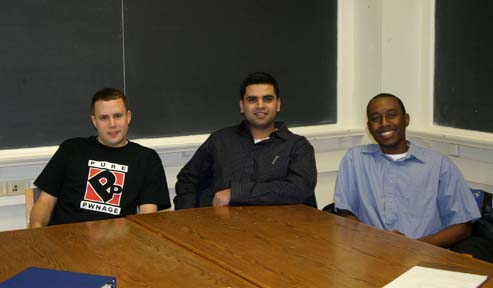Purpose
This course surveys current topics in computer network security, including technology to protect networks, protocols and applications from intrusion and theft. Topics include techniques for authentication, privacy, denial of service, and non-repudiation. Current Internet distributed security models and protocols are discussed in the context of these techniques. Of special importance are the application to Internet infrastructure protocols, such as Internet routing and transport protocols, as well as secure mail, directory and multimedia multicast services.
Knowledge of cryptographic algorithms, such as discussed in a related course: Cryptographic Techniques with Computer Network Applications, is helpful, but not essential. This course: Computer Network Security is based largely on material being discussed by the working groups of the Internet Engineering Task Force, specifically the IPSEC Task Force and the Security and Privacy Research Group. Background material will be provided in the form of handouts and links to information on Internet archive and web sites.
Requirements
Prerequisites: ELEG651 or CISC650 or permission of instructor
Exams: TBA
 |
Text: Stallings, W. Cryptography and Network Security: Theory and Practice, Second Edition |  |
Reference (optional): Schneier, B. Applied Cryptography - Protocols, Algorithms, and Source Code in C, Second Edition. John Wiley and Sons, 1995, ISBN 0-471-59756-2 |
 |
Reference (recommended): Stinson, D.R. Cryptography - Theory and Practice. CRC Press, Boca Raton, FA, 1995, ISBN 0-8493-8521-0. |  |
Additional (optional): Denning, D. Information Warfare and Security. ACM Press, 1999. ISBN 0-201-43303-6 |
 |
Additional (optional): Denning, D., and J. Denning. Internet Besieged: Countering Cyberspace Scofflaws. ACM Press, 1998. ISBN 0-201-30820-7 |  |
Additional (optional): Stein, L.D. Web Security: A Step-by-Step Reference Guide. Addison Wesley Longman, Inc., 1998. ISBN 0-201-63489-9 |
 |
Informational: Burrows, W. Deep Black. Berkeley Publishing Group, 1986. ISBN 0-425-10879-1. Spy satellites and the National Security Agency. |  |
Informational: Levy, S. Crypto. Penguin Putnam, Inc., 2001. ISBN 0-670-85950-8. Political history on cryptography and the US government. |
 |
Informational: Stoll, C. The Cuckoo;s Egg. Pocket Books, 1989. ISBN 0-7434-1146-3. True story about tracking down a hacker spy. |
Course Materials
- Course notes, lecture materials and links to other sites
- Cryptographic algorithms, including demonstration programs, sources and documentation from the RSI Labs rsaref2.0 distribution
- Public key security standards, including RSA Labs PKS standards and IETF RFCs
- Cryptographic algorithms from Schneier, B. Applied Cryptography - Protocols, Algorithms, and Source Code in C, Second Edition
- Open SSL home page (cryptographic algorithms and utilities)
Syllabus
-
Introduction
History and perspective: The Puzzle Palace, Bletchly Park and the Enigma
Narrowing the objectives in this course
US and foreign security politics (Chapter 25 in Schneier)
Private initiatives: IETF research and engineering groups -
Security models
Military and civil security, vulnerability and threat models
End-end security (COMSEC), link encryption (TRANSEC), compartments
Privacy, authentication, denial of service, non-repudiation
Overview of private-key (DES) and public-key (RSA) cryptographic algorithms
Encapsulation and encryption principles
Issues in multilevel secure systems
Internet security models: IPv4/v6 encapsulation header -
Network layer security
Routing algorithm vulnerabilities: route and sequence number spoofing, instability and resonance effects
Information hiding: DMZ networks, route aggregation and segregation
ICMP redirect hazard: denial of service
ARP hazard: phantom sources, ARP explosions and slow links
Defending against Chernobyl packets and meltdown
Fragmentation vulnerabilities and remedies: (ICMP Echo overrun) -
Transport and application layer security
Techniques for fault detection, isolation and repair
Secure network infrastructure services: DNS, NTP, SNMP
Privacy enhanced mail (PEM)
Secure binding of multimedia streams: Secure RTP
Secure admissions control and authentication: Secure RSVP
Mobile systems: address export and re-use
Session key management: blind-key cryptosystems (NTP) -
Firewalls
Secure access control and management: secure SNMP
Secure routing interoperability: virtual networks (DARTnet/CAIRN)
Transparent and opaque network services
Source masking and hidden channels -
Key and certificate management
Secure binding of public and private values: DNS certificates
Making and distributing key media: randomization, lifetime issues
Key agreement protocols: STS protocol and IETF work orders
Key distribution protocols: Kerberos
Key escrow: the Clipper chip
One-time passwords: schemes based on S/KEY -
Case studies of algorithm and protocol vulnerability
The ARPANET Black Tuesday meltdown: computer memory failure
The 1990 AT&T breakdown: program failure
The Cuckoo's Egg: password cracking -
Security techniques based on fault-tolerant computing (optional)
Exploiting diversity and redundancy: Byzantine generals
Timestamping and reliable ordering of events: NTP
Consensus and agreement protocols












